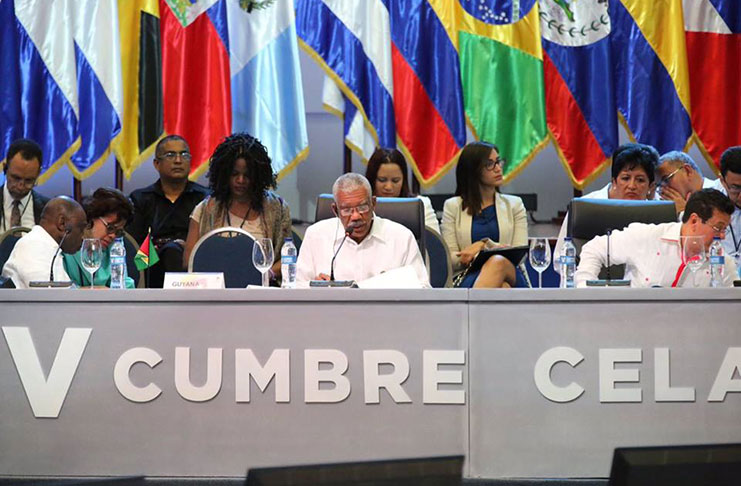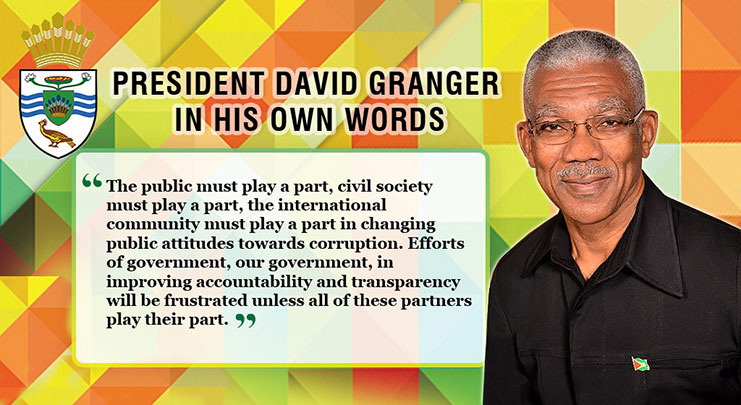The Caribbean Community serves as one of the longest surviving integration movements among developing countries and seeks to promote economic integration and cooperation among its members. Guyana is home to the CARICOM Secretariat Headquarters and was
among the four founding member states of CARICOM which was established in on July 4, 1973 under the Treaty of Chaguaramas. In the years since its establishment, CARICOM has made significant strides in promoting regional cooperation in areas of education, health, culture and security.

In January of this year, Guyana assumed Chairmanship of CARICOM and President David Granger pledged to continue to guide the Community on the path of sustainable development and to advance the regional integration process. In his New Year message to the Caribbean Community, President Granger said that it is in the interest of developing the economies of the region for the benefit of the people of the Caribbean that CARICOM is taking steps to ensure that they are fully equipped to address the requirements of the 21st Century economy and society.

The President said that timely assessments will also be made to maximise the benefits of the CARICOM Single Market and Economy (CSME), the vehicle through which the region can achieve growth and development. But more importantly, the President plans to strengthen the pursuit of a Green Economy within the region and has said that CARICOM nations are well endowed with the requirements for this goal.
“The effects of climate change continue to bedevil our countries as exemplified by Hurricane Matthew. The need to conserve and protect our environment, therefore, becomes even more pressing,” the President said in his message. Such actions, he continued, will also present the opportunity to leverage the abundant forests and wetlands as well as the marine resources of the Region and utilise them creatively to launch new pathways to social and economic

development. “This can be accomplished while ensuring that we help in the global commitment to limit the rise in global temperature to below 1.5 degrees,” President Granger said.
With the Chairmanship of CARICOM occurring on a rotational basis, President Granger has been prepared for the upcoming position for quite some time and had streamlined key areas of focus that he would tackle once taking up the positon.
On the January 20 edition of the Public Interest, President Granger said that he will continue to build on the work of the founders as well as his predecessor, Prime Minister of Dominica, Roosevelt Skerrit. He said though, that much of his focus will go into advancing economic integration. “The CARICOM Single Market and Economy is very important to me and once we get the economy right I’m sure some other forms of cooperation will follow. There has been some challenges in the Caribbean… many of those countries have turned to Guyana as a place for investment… My thrust would be in the economy and I would like to more quickly toward building that CSME,” he said.
Focus on advancing the CSME was also a key point of discussion at the thirty seventh Regular Meeting of the Conference of Heads of Government of CARICOM held in Guyana, in July last year. At the opening ceremony, CARICOM’s Secretary General, Ambassador Irwin La Rocque, said that it is integration that will allow member states to achieve a level of development that the people desire and deserve.

The Meetings also featured discussions on the border relations between Guyana and Venezuela and Belize and Guatemala and other issues. Guyana has received support from CARICOM with regard to the Guyana/Venezuela Border Dispute. In fact, during a visit to President Granger in June last year, Ambassador LaRocque said that CARICOM remains unwavering in its determination to preserve Guyana’s territorial integrity. “It is an issue that we are always on, at appropriate junctions, statements have been issued… and the matter of Guyana’s territorial integrity is sacrosanct and the Community will always be supporting Guyana in this issue,” the Ambassador said.
Since assuming Chairmanship, President Granger has made representation on behalf of CARICOM at high-level forums. On January 25, the Head of State attended the Fifth Summit of State and Government of the Community of Latin American and Caribbean States (CELAC) in Punta, Cana, Dominican Republic. There, he furthered CARICOM’s agenda by stating that the Caribbean Community looks to CELAC to complement the integrative process especially in light of varied economic, environmental and security threats that the member states face.
During an interview on the side lines of his visit at the CELAC Summit, the President reiterated his concern for issues affecting Small Island Developing States (SIDs) and his wish to ensure that the relations between the large and small states within CELAC are strengthened. “My intention is to ensure that the interests of the community as a whole are served by ensuring that the relationships between the larger states and the smaller states remain on an even keel and work toward the benefit of all our peoples,” the President said. 
The President also called on CELAC to erect institutions and agencies, which possess the capability of preventing conflict, promoting peace and of pursuing peace-making initiatives in order to give meaning to the Region’s quest to be a Zone of Peace. These institutions and agencies would prove useful, especially in light of the ongoing border controversy between CELAC member states Guyana and Venezuela.
Apart from his attendance at the CELAC Summit, the President also attended the Inauguration of the 58th President of the Republic of Haiti, His Excellency Jovenel Moise on February 7.
There, the President said that that his presence represented CARICOM standing in solidarity with Haiti which has suffered major catastrophes over the past 15 years. The President said that CARICOM will be working to ensure that it aids in the revival of the Haitian economy. “We expect that at the next intercessional meeting of the CARICOM Heads of Government and Heads of State, we will address the economy and we feel that Haiti has a very important role to play in producing goods for that economy and also in attract investments from donor countries… Haiti is a big market and we would like to see Haiti recover from its  environmental problems as quickly as possible because what is good for Haiti is good for the Community,” the President said.
environmental problems as quickly as possible because what is good for Haiti is good for the Community,” the President said.
CARICOM will also look at maintaining its strong relations with the United States, which, President Granger has said has remained fruitful over the years through the established Caribbean Basin Security Initiative. Guyana’s Chairmanship of the Caribbean Community places the country in a pivotal position to help to deepen regional integration among member states while addressing key concerns affecting small island developing states.



.jpg)










